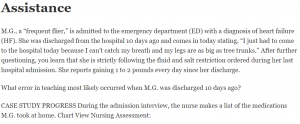Assistance

M.G., a “frequent flier,” is admitted to the emergency department (ED) with a diagnosis of heart failure (HF). She was discharged from the hospital 10 days ago and comes in today stating, “I just had to come to the hospital today because I can’t catch my breath and my legs are as big as tree trunks.” After further questioning, you learn that she is strictly following the fluid and salt restriction ordered during her last hospital admission. She reports gaining 1 to 2 pounds every day since her discharge.
What error in teaching most likely occurred when M.G. was discharged 10 days ago?
CASE STUDY PROGRESS During the admission interview, the nurse makes a list of the medications M.G. took at home. Chart View Nursing Assessment:
Medications Taken at Home Enalapril (Vasotec) 5 mg PO bid Pioglitazone (Actos) 45 mg PO every morning Furosemide (Lasix) 40 mg/day PO Potassium chloride 20 mEq/day PO
Which of these medications may have contributed to M.G.’s HF? Explain
After reviewing M.G.’s medications, the physician writes the following medication orders. Chart View Medication Orders Enalapril (Vasotec) 5mg PO bid Carvedilol (Coreg) 3.125mg PO twice daily Glipizide (Glucotrol) 10mg PO every morning Furosemide (Lasix) 80mg intravenous push (IVP) now, then 40mg/day IVP Potassium chloride (K-Dur) 20mEq/day PO
What is the rationale for changing the route of the furosemide (Lasix)?
You administer furosemide (Lasix) 80mg IVP. Identify three parameters you would use to monitor the effectiveness of this medication
What laboratory tests should be ordered for M.G. related to the order for furosemide (Lasix)? Select all that apply.
a. Magnesium level
b. Sodium level
c. Complete blood count (CBC)
d. Serum glucose level
e. Potassium level
f. Coagulation studies
What is the purpose of the beta blocker carvedilol? It is given to:
a. increases the contractility of the heart.
b. cause peripheral vasodilation.
c. increase urine output.
d. reduces cardiac stimulation from catecholamines
You assess M.G. for conditions that may be a contraindication to carvedilol. Which condition, if present, may cause serious problems if the patient takes this medication?
a. Angina
b. Asthma
c. Glaucoma
d. Hypertension
One day later, M.G. has shown only slight improvement, and digoxin (Lanoxin) 125 mcg PO daily is added to her orders. 9. What is the action of the digoxin? Digoxin:
a. causes systemic vasodilation.
b. promotes the excretion of sodium and water in the renal tubules.
c. increases cardiac contractility and cardiac output.
d. blocks sympathetic nervous system stimulation to the heart
Coronary Artery Disease and Prevention
| Family History Father died suddenly at age 42 of a myocardial infarction (MI) Mother (still living) had a quadruple coronary artery bypass graft (CABG×4) at age 52
Past History and Current Medications Metoprolol (Lopressor) 25mg PO every 12 hours Aspirin (ASA) 325mg per day PO Simvastatin (Zocor) 20mg PO every evening Lifestyle Habits Has smoked an average of 11 ⁄2 packs of cigarettes per day (PPD) for the past 20 years Drinks an “occasional” beer and “a six-pack every weekend when watching football” Dietary history: High in fried and fast foods because of his traveling Exercise: “I don’t have time to take walks.” General Assessment White Male Weight 235lb Height 5ft, 8 in Waist circumference 48 in Blood Pressure 148/88mm Hg Pulse 82 beats/min Respiratory rate 18 breaths/min Temperature 98.4° F (36.9° C) |
There are several risk factors for coronary artery disease (CAD). For each risk factor listed, mark whether it is nonmodifiable or modifiable.
a. Age
b. Smoking
c. Family history of CAD
d. Obesity
e. Physical inactivity
f. Gender g. Hypertension
g. Hypertension
h. Diabetes mellitus
i. Hyperlipidemia
j. Ethnic background
k. Stress
l. Excessive alcohol use
Circle the nonmodifiable and modifiable risk factors that apply to B.T
view B.T.’s most recent laboratory results. Chart View Laboratory Testing (Fasting)
Total cholesterol 240 mg/dL HDL 35mg/dL LDL 112mg/dL Triglycerides 178mg/dL
Which laboratory values are of concern at this time? Explain your answers
B.T. asks you, “So, how is my ‘good cholesterol’ doing today?” Which is considered the “good cholesterol,” and why? What do his HDL and LDL levels indicate to you?
B.T. laughingly tells you he believes in the five all-American food groups: salt, sugar, fat, chocolate, and caffeine. Identify health-related problems in this case description; the problem that is potentially lifethreatening should be listed first
Of all of B.T.’s behaviors, which one is the most significant in promoting cardiac disease?
B.T. is uncomfortable, and he has an unopened bottle of sublingual nitroglycerin (SL NTG) tablets. His blood pressure is 158/98, and his pulse is 122. You decide to give him one tablet. After 5 minutes, which is the appropriate action to take?
a. If the chest discomfort is relieved, call 911.
b. If the chest discomfort is not relieved, give another SL NTG tablet, and wait 5 minutes more.
c. If the chest discomfort is not relieved, have someone else call 911 while you give B.T. another SL NTG tablet.
d. If the chest discomfort is not relieved, obtain a 12-lead electrocardiogram (ECG) to look for ischemic changes, and call 911.
Five minutes after the first NTG tablet, B.T. states that the discomfort is still there and only slightly relieved. Explain what you can expect to be doing while waiting for emergency medical system (EMS) personnel to arrive
After taking the second NTG SL tablet, B.T. complains of a “terrible headache” and worries that he is getting worse. What is happening, and what should you tell him?